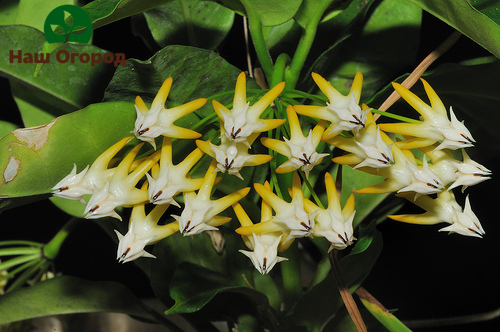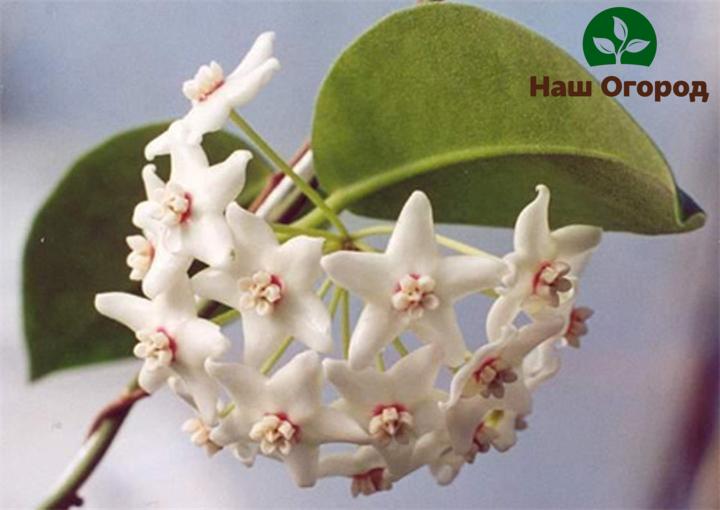Outlandish hoya: varieties and methods of reproduction
Content:
Within an enclosed space, hoya can be grown in three ways: 1) like a liana in a hanging planter; 2) as ivy, around any support; 3) as a bush with a straight stem. Each method requires a different kind of hoya.
Hoya varieties and varieties:
Majestic hoya
Grows like a climbing shrub species. The foliage is oval-shaped, with a small pointed tip at the end. Quite large, because in their length they can reach twenty centimeters. The leaves themselves are glossy. A hat of flowers in its shape resembles an umbrella, usually there are several of them on a plant, each with many flowers. The inside of the flower is dark scarlet, and on the outside it is yellow-green.
Lovely hoya
The type of plant is ampelous. Feels great in heat and high humidity. In appearance, it looks more like a creeping shrub. On the shoots, there are small leaves two and a half centimeters in size. It blooms in small white flowers, the core of which ranges from red to purple. Blooms very profusely throughout the season. The aroma is not as strong as in other types of it, so it can be placed in any room.
Green variety
A very sensual and expressive plant. The foliage is elongated. And the flowers seem to be velvet, can be: green, brown and white shades.
Meaty hoya
Practically the most popular vine. It can grow up to six meters. Due to its fast and confident growth, you will have to tie up or put up a support so that the thin stems of the plant feel comfortable. Also, this type of vines has its own varieties, each has different inflorescences. They are either pink with a whitish border, or bright scarlet with a green border, there are even those that change color as they grow older.
Motooskei hoya
It is also a rather long liana, which in its growth can reach six meters. The stems are down-creeping. Foliage in shape can resemble an elongated heart, very dense and glossy. Up to eight centimeters long and up to four centimeters wide. It blooms with light beige flowers with a pink heart. Smells very nice.
Multiflora hoya
The most unusual of all varieties. Grows in the form of ivy with elongated foliage. It begins to bloom early. Its bloom is elongated orange flowers with narrow yellowish petals in the form of a star with a tip in the very middle. Most varieties have fairly large leaves, but there are also specimens with smaller foliage.

Kerry Hoya
Probably the cutest of all the varieties. It looks like ivy, which was discovered in the last century. The view is very attractive, the stems are very long, so you have to tie them up. In one umbrella of flowers, there are about fifteen to twenty pieces. The shade of the flower depends on the sun's rays, that is, it can vary from whitish with light yellow to bright yellow with a pink tint. Even the older the plant becomes, the darker shades its inflorescences acquire. The foliage is shaped like hearts. You can propagate with one leaf.
Concave hoya
Also quite an interesting view. Foliage in the form of small diamonds, faint green with a richer border. The scent of the flowers is reminiscent of a perfume with woody notes. The yellow heart of the flower seems to lie on a white fringed pillow. A fairly unpretentious plant, with which all hoya lovers begin.
Cup-shaped hoya
It grows with a straight stem.The leaves are quite long, can reach up to twenty centimeters in length. The color is five-pointed stars with a purple core.

Hoya bloom features
For her to bloom, you will need to provide her with bright, but diffused sunlight. If she receives it, then she will give you a long and fragrant flowering.
Hoya breeding methods
There are several different ways to propagate this beautiful plant at home.
With the help of seeds. This is probably the most difficult method, but it is real. It is quite difficult to buy hoya seeds in the store, but it is difficult to get seeds from your plant yourself, because they rarely ripen to the end. Basically, this method is used by professionals. After the flowers of the hoya fade, seeds appear. Only fully ripe and dried seeds are suitable for further planting. You need to plant in the same year in which they were harvested, or they will simply lose this ability. It is necessary to plant in a small greenhouse, which must be kept in conditions of high humidity, in a place with light and warmth. Airing is also required. The seeds should rise in about a week, but they will grow slowly. After about three months, the first leaves should appear, then you can begin to transplant each into a separate pot. Also, do not forget about the prevention of spraying from fungal infections.
Using layering... This is a fairly simple and effective breeding method. With this method, the plant can begin to bloom in the first year. This will require an adult crop with a long stem so that it can be transferred to another pot. There it needs to be strengthened with a hairpin or stick. A shallow incision must be made in the same place. Then cover it with a layer of moss, water and cover with a film. Next, you need to wait for rooting and the appearance of the first leaves. When the culture is already getting stronger, then it can be cut off from the adult plant.
With the help of cuttings. This is probably the easiest way to breed hoya. You need to start by choosing a shoot, which will have three internodes and two or three pairs of leaves. Next, you need to put it in a glass of water and add fertilizer there for the speedy formation of the root system. The water should be warm and settled. You can also cover it with foil, but be sure to ventilate it. The roots will appear in a couple of weeks. However, you need to wait until they are more or less strong before replanting them in a full-fledged pot. You need to put it in a warm place and if after about three weeks, young leaves appear, this will mean that everything is going as it should. However, hoya grown in this way will begin to bloom only after four years.
With the help of leaflets... This method is not suitable for all types of hoya. But there is also a possibility that a root system is formed in the leaf, but it is not a fact that it will grow and develop further.

